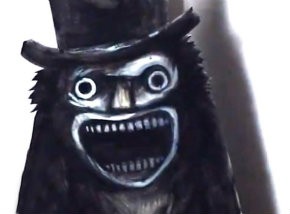A complex movie monster

As Tolstoy said, “every unhappy family is unhappy in its own way.” And some forms of unhappiness are more frightening than others. The Australian horror film The Babadook, by Jennifer Kent, centers on a mother (Amelia) and son (Samuel) seven years after the death of their husband and father, Oskar—a death that occurred while rushing Amelia to the hospital for Samuel’s birth.
When the superbly acted film begins all Amelia and Samuel have is grief, loneliness, and each other. This grief has “islanded” them—with failures both institutional and familial contributing to their solitude. Yet their isolation is understandable. Grief has made Samuel sickeningly needy and even dangerous. He brings a homemade crossbow to school and breaks his cousin’s nose at her birthday party. The loss has made Amelia depressed and exhausted. “I just need to sleep” is her almost liturgical lament. Grief acts as a twisted gravity, only pulling in more pain, more loneliness.
But terror slips into their lives with the appearance of a children’s pop-up book and the monster it is named after, Mister Babadook. The haunting starts with eerie tricks but quickly becomes vicious: chilling calls, pounding knocks at the door, glass in their dinners, shadows filled with the undertaker-esque monster and his spiked hands.
The Babadook has a Calvin and Hobbes quality to it: is Hobbes alive or isn’t he? Whose grief or what netherworldly realm does the monstrous Babadook spring from? Perhaps he’s simply a metaphor for the terrors of parenting or specifically of motherhood. Where does this dangerous web of interlocking fears find purchase in fact?
Amelia engages in an array of methods to rid her and Samuel of their relentless monster: denial, sleeping pills, going to the police, sleep deprivation, burning the pop-up book. But as her slow psychological disintegration continues, the Babadook just grows bolder and more dangerous. This grief, and this monster, refuses to be managed.
In American horror, most monsters are easily understandable. Their identity, their reasons for existence, the rules they haunt or kill by, the procedure for their defeat—all this tends to be clear and identifiable. Wes Craven says there are two types of horror stories told around campfires. One imagines the monsters as “out there,” beyond the light the campfire casts, lurking in the dark woods of the world around us. The other draws the boundaries differently: the monsters are here, illumined by the fire’s light, most likely sitting around it. The monsters are us.
Kent’s movie has the moral imagination to tell both of these stories simultaneously. The Babadook is partially Amelia’s metastasized anguish, but it is not reducible to this anguish. Here, the screen teaches us about life. Our monsters are us, but they are more than us.
The individual might be the face of evil, but like a warped inversion of the body of Christ, he or she is a single tentacle of a larger monster. Exorcising the evil out of the individual isn’t enough. We frequently participate in something “bigger than ourselves,” but not in a way we anticipate. In an almost Pauline way, The Babadook reminds us that evil involves individuals as well as the powers and principalities.
Many horror films are nothing but the formulaic trick itself, a spray of blood or a brief startle. The Babadook’s unsettling story of a mother and son’s relationship provides more. There is a depth to how it says “boo.”





